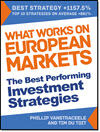You know that Value and Momentum investing are powerful strategies, but should you blend them or keep them separate? This article breaks down decades of research to show you the best way to combine these strategies for higher returns and lower risk.
You’ll learn how to structure your portfolio, how often to rebalance, and why a 50/50 split with separate portfolios outperforms a blended approach. If you want to maximize returns with a simple, research-backed strategies, this article will show you exactly how to do it.
Estimated Reading Time: 6 minutes
Value and Momentum Investing: Better Together or Apart?
If you have found this article you know that Value and Momentum investing, are two powerful investment strategies that have historically beaten the market.
The question you may have asked yourself is: Should you combine them into one portfolio (select companies based on value and momentum), or keep them separate (one pure value portfolio and one pure momentum portfolio)?
Researchers at Alpha Architect have studied this question for years. In this article, we’ll discuss their back tests of these strategies over different periods and across U.S. and international markets.
The results help you decide on the best way to invest your own money. By the end of this article, you will know exactly how to use Value and Momentum, how often to rebalance, and what trade-offs you can expect.
Understanding Value and Momentum Investing
Value investing means buying stocks that are cheap based on fundamental measures, like earnings-to-price (E/P) or EBIT/TEV. These companies are often out of favour but tend to recover over time, delivering strong returns.
Momentum investing, on the other hand, is about buying stocks that have been going up in price because winning stocks often continue rising.
The key reason Value and Momentum work well together is that they are opposites.
When Value stocks struggle, Momentum stocks tend to perform well, and vice versa. That makes them a great combination for reducing risk.
But how you combine them matters.
Click here to start finding ideas that EXACTLY meet your investment strategy.
Should You Combine or Separate Value and Momentum?
The first study, Value and Momentum Investing: Combine or Separate? (2021), tested this question from 1992 to 2021 using large and mid-cap stocks in the U.S. and international markets.
The researchers found that keeping Value and Momentum separate and then combining them at the portfolio level produced higher returns than blending them together into one stock selection process.
This was especially true for concentrated portfolios (holding 50-100 stocks). However, as portfolios grew larger (200+ stocks), the performance difference became smaller. The study also tested monthly vs. annual rebalancing.
Monthly rebalancing slightly improved returns but increased taxes and trading costs. Annual rebalancing had almost the same returns but was easier to manage.
US Companies
Source: Value and Momentum Investing: Combine or Separate? (2021),
International Companies
Source: Value and Momentum Investing: Combine or Separate? (2021),
The Best Way to Combine Value and Momentum
The second study, How to Combine Value and Momentum Investing Strategies (2015), tested different ways to mix these strategies using data from 1963 to 2013. It found that a 50/50 allocation to separate Value and Momentum portfolios had stronger performance than blending them into one stock selection process.
This study also tested quarterly vs. monthly rebalancing.
Quarterly rebalancing worked well, balancing cost and tracking error. Monthly rebalancing slightly improved performance but led to more frequent trading, increasing costs and taxes.
The key takeaway?
Holding separate Value and Momentum portfolios and rebalancing them quarterly or annually is more effective than blending them into one selection process.
Source: How to Combine Value and Momentum Investing Strategies (2015)
Value = EBIT VW = Highest 10% of companies ranked on Value (EBIT/TEV). Portfolio is value weighted.
Momentum = MOM VW = Highest 10% of companies ranked on 12-1 month Momentum. Portfolio is value weighted.
Value and Momentum Combined = COMBO VW = Rank companies independently on both Value and Momentum. Add the two rankings together. Select the highest 10% of companies ranked on the combined rankings. Portfolio is value weighted.
Value and Momentum Separate = 50% EBIT/ 50% MOM VW = Each month, invest 50% in the EBIT VW portfolio, and 50% in the MOM VW portfolio. Portfolio is value weighted.
Click here to start finding ideas that EXACTLY meet your investment strategy.
Why You Should Use Both Value and Momentum
The third study, Why Investors Should Combine Value and Momentum Investing Strategies (2016), used data from 1927 to 2015 to test how these strategies perform over long periods.
It confirmed that Value and Momentum work well together because they tend to perform well at different times.
The study also tested dynamic rebalancing, where investors adjusted weights based on recent performance. While this approach had potential, it was hard to execute.
A simple 50/50 allocation with annual rebalancing provided similar benefits while being much easier to manage. If you want steady returns with fewer painful drawdowns, combining Value and Momentum is a smart move.
The 89 Year Back Test 1927-01-01 To 2015-12-31 – After Fees
Source: Why Investors Should Combine Value and Momentum Investing Strategies (2016)
50% Value, 50% Momentum: A strategy that invests 50% in the Value portfolio and 50% in the Momentum portfolio described below. Rebalancing the portfolio to 50%/50% every month. This returns stream is net of the fees described below for value and momentum.
Value: Top Decile of firms ranked on Book to Market (B/M) from Ken French’s website. We use the value weight portfolio returns and deduct 0.25% annually for the annual rebalance.
Momentum: Top Decile of firms ranked on Intermediate-Term momentum (past 12 months excluding last month) from Ken French’s website. We use the value-weight portfolio returns and deduct 3.00% annually for the twelve monthly rebalances (0.25% per rebalance).
SP500: The total return to the S&P 500, this return stream is gross of any fees.
How Often Should You Rebalance?
Rebalancing keeps your portfolio on track, but how often you do it affects performance, taxes, and costs. Here’s what the research suggests:
-
Monthly rebalancing: Increases returns slightly but creates more trading costs and short-term tax issues.
-
Quarterly rebalancing: A good balance between performance and cost.
-
Annual rebalancing: Almost the same returns as monthly but much lower costs and taxes.
For most individual investors, quarterly or annual rebalancing is best. Monthly rebalancing is more suited for professionals who can manage trading costs.
How to Apply This to Your Portfolio
If you want to maximize returns while keeping risk low, here’s what you can do:
-
Create two separate portfolios: One for Value stocks, one for Momentum stocks.
-
Allocate 50% to each to get the best diversification benefits.
-
Rebalance quarterly or annually to stay on track without incurring too high costs.
-
Hold these investments in tax-advantaged accounts to minimize tax impact.
Value Strategy
For Value investing, we recommend two effective strategies Qi Value and Quant Value Composite. Both ranks stocks based on a composite of value metrics rather than a single ratio.
The Qi Value strategy uses the following ration combined into one valuation rank:
· EBITDA Yield (EBITDA / EV)
· Earnings Yield (EBIT / EV)
· FCF Yield (FCF / EV)
· Liquidity (Q.i.) (Operating profit / Yearly traded value)
The Quant Value Composite strategy uses the following ration combined into one valuation rank:
· Price to Sales: The lower, the better,
· Price to Earnings (PE): The lower, the better,
· EBITDA Yield or EBITDA to EV: The higher, the better,
· FCF Yield (FCF to EV): The higher, the better,
· Shareholder Yield: The higher, the better.
Momentum Strategy
For Momentum, we recommend 12-1 month momentum which ranks stocks based on their total return over the past 12 months, excluding the most recent month. This avoids short-term mean reversion, where stocks that performed well in the last month often experience pullbacks. The 12-1 momentum signal helps capture stocks with strong, sustained trends, maximizing the power of momentum investing.
Or the Adjusted Slope 125/250d momentum strategy.
By following these strategies, you get the best of both worlds—higher returns and a smoother ride through market ups and downs.
Click here to start finding ideas that EXACTLY meet your investment strategy.
Conclusion
Research shows that keeping Value and Momentum separate but combining them at the portfolio level produces better returns than blending them into a single selection process.
Quarterly or annual rebalancing is the sweet spot for balancing performance and cost.
If you want a powerful, research-backed investment strategy, consider adding both Value and Momentum to your portfolio.
By taking a disciplined, systematic approach, you can make smarter investing decisions and build lasting wealth.
FREQUENTLY ASKED QUESTIONS
1. Should I invest in Value or Momentum stocks?
You don’t have to choose—research shows that combining Value and Momentum works best. Value stocks are cheap but take time to recover, while Momentum stocks are rising but can fall fast. When one struggles, the other tends to do well, which smooths out your returns. The best approach? Invest in both.
2. Should I pick stocks based on both Value and Momentum, or keep them separate?
Keeping them separate leads to better performance. Studies show that having two distinct portfolios—one for Value and one for Momentum—delivers higher returns than blending them into a single stock selection process. A 50/50 split gives you the best of both worlds.
3. How often should I rebalance my portfolio?
It depends on your goals and costs.
-
Monthly rebalancing slightly improves returns but increases trading costs and taxes.
-
Quarterly rebalancing is a great balance—good returns with lower costs.
- Annual rebalancing is the easiest and still delivers strong returns with minimal tax impact. For most individual investors, quarterly or annual rebalancing is the best choice.
4. How many stocks should I hold in my Value and Momentum portfolios?
If you want the strongest results, aim for a concentrated portfolio of 50-100 stocks in each strategy. This size captures the benefits of Value and Momentum without watering down performance. If you hold 200+ stocks, the performance difference between separate and blended strategies becomes smaller.
5. Can I use Value and Momentum in a tax-advantaged account?
Yes! If you can, hold these investments in a tax-advantaged account. This helps you avoid short-term capital gains taxes, especially for Momentum stocks, which require more frequent trading. If you’re investing in a taxable account, stick with annual rebalancing to minimize tax costs.
6. What’s the best way to pick Value and Momentum stocks?
For Value, don’t rely on a single metric. Instead, use a composite ranking that includes:
-
EBITDA Yield
-
Earnings Yield
-
Free Cash Flow Yield
-
Shareholder Yield
For Momentum, use the 12-1 month momentum rule, which looks at total returns over the last 12 months but ignores the most recent month. This avoids short-term price swings and focuses on stocks with sustained upward trends.
7. What’s the biggest mistake investors make with Value and Momentum investing?
The biggest mistake is abandoning the strategy when it underperforms. Both Value and Momentum go through rough periods, but history shows they always recover. The key is sticking to the plan, staying diversified, and rebalancing on schedule. If you keep jumping in and out, you’ll miss the best returns.
Click here to start finding ideas that EXACTLY meet your investment strategy.


